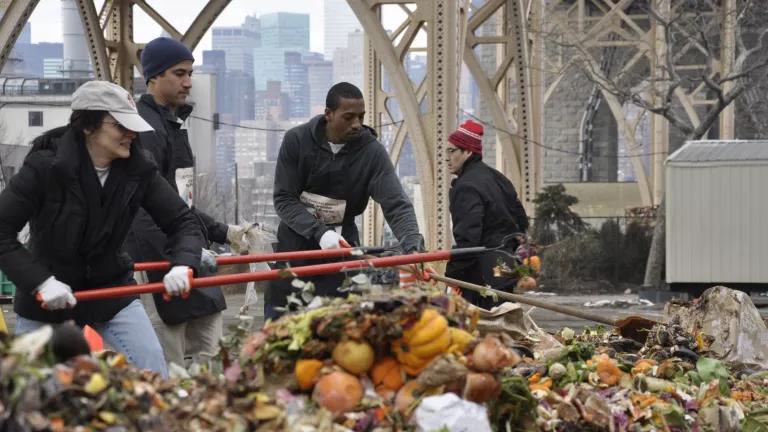"A city is like a pizza, and a neighborhood is like a slice of pizza. Just as a slice of pizza should contain all the ingredients of the pizza, each neighborhood should contain all the things we enjoy and value about the city: homes, coffee... shops, ball fields, churches, grocery stores, and so on. The suburban experiment that was so influential in the 20th century involved dividing up the functions of the city into different zones: housing, shopping, office, recreation. This works about as well as eating the elements of your pizza in different courses: you're still getting the same nutritional value, but you've lost the joy of your pizza." -- Eric Jacobsen, Why Suburbia is Affecting Your Spiritual Life
Sustainability. We use that word to describe enhanced quality of life in communities characterized by "smart growth" development. A key component of sustainability is better transportation, which means people have more choices for mode of travel than just by car. Public transit -- whether by bus, streetcar, commuter train or light rail system -- is beneficial for many reasons, even for those who choose not use it. The benefits include: less congestion, easier and less stressful commutes, less road maintenance, fewer accidents and, of course, the significant environmental benefits of improved air quality and fewer greenhouse gas emissions.
Most Americans probably don't realize that for pollution emitted by the burning of fossil fuels, transportation trails only electricity generation in the U.S. Indeed, tailpipe emissions make up 28% of total carbon pollution, ranking No. 2 behind smokestack emissions from coal-fired power plants. So it’s clear that reducing the number of miles Americans travel is one of the most important strategies for reducing carbon emissions, and in so doing, helping slow down global climate change.
But aside from the tremendous environmental and health benefits of more transit and less driving, there is an economic payoff that is often overlooked. It has to do with housing -- specifically, housing located near transit. Let's stop and take a moment to consider some interesting and important aspects of this particular issue.
1. People are learning to love living downtown again.
The New York Times recently ran a story reflecting the dilemma cities are facing today in meeting new market demand for urban, livable neighborhoods, while dealing with an historic legacy of building highways through these same neighborhoods for the sake of suburbia. Back the late 1960's, during the height of the interstate construction era, all roads seemingly led to prosperity -- or so it was believed. But we now see how highways have in many cases hurt communities financially, by spawning suburban sprawl that fosters long commutes, massive infrastructure costs, and the draining of the economic vitality of downtown business districts. However, as the article notes, more and more cities lately have been tearing down postwar highways that ripped through downtowns, replacing them with parks and streets and neighborhoods. All over America, revitalizing downtowns is all the rage and cities are reaping the economic rewards generated by re-developing vibrant urban communities. This shows that if you build it downtown, people will come...to shop and settle.
2. Housing and transit together are a win-win.
A new policy analysis by Reconnecting America details how locating affordable housing near transit is good for the local economy. As might be expected, enabling lower-income households convenient access to transit helps to create successful economies by linking workers to jobs and consumers to businesses. But consider this remarkable finding: tax revenues are about equal between locating affordable or market rate housing near transit. See, everybody living closer to transit wins -- not just people who commute on public transportation.
3. Transit-friendly housing is holding its value better.
Would you believe that during this economic downturn the impact on housing prices have been been significantly less in the inner city? Consider Philadelphia. A new study by the Congress for the New Urbanism documents the remarkable turnaround in the impact of housing downturns there on home prices. To wit:
During the first housing downturn of 1989-1995, housing prices declined the greatest in the urban core center (-33.7% in the center city), second-most in the central city of Philadelphia as a whole (-17.6%) and least in the lower-density areas of the suburban counties (-14.3%). But during the most-recent housing downturn of 2007-2012, home price declines have been the greatest in the low-density suburbs (-32.7%), second-most in Philadelphia County (-26.7%) and the smallest in the urban core of the center city (-20.2%).
The reason for this slower decline in housing prices in the urban core is attributed to three factors: (1) higher energy prices that made living in the suburbs in large houses with long work commutes more expensive (2) urban revitalization and better urban design in the inner core, and (3) changing customer preferences, among both seniors and the younger generation (so-called Millennials), for more walkable communities and more active street-life.
4. Location-efficiency, location-efficiency, location-efficiency.
This point is somewhat related to the previous point about higher home values in areas closer to transit. A couple of years ago, while the nation continued to grapple with a troubling housing market and a rash of mortgage defaults, new research emerged drawing a direct link between “location efficiency”—a measure of the transportation costs in a given area—and mortgage foreclosure rates. The study, conducted by my colleague David Goldstein, shows that factors such as neighborhood compactness and access to public transit are key to predicting mortgage performance and therefore should be taken more seriously by mortgage underwriters, policymakers, and real estate developers. With transportation costs accounting for roughly 17 percent of the average American household’s income, the need for better land use planning and better lending practices has never been more clear. David's insightful research demonstrates the need for changes both to planning-related policies and mortgage underwriting procedures that can reduce transportation costs and risk of foreclosure while offering significant environmental benefits.
5. Wither suburbia?
I just have to put in a plug about a quirky and somewhat surreal documentary about soul-sucking suburbia from a few years ago called "Radiant City." As the film's website describes the premise: "Since the end of World War II, one of kind of urban residential development has dominate how cities in North America have grown, the suburbs. In these artificial neighborhoods, there is a sense of careless sprawl in an car dominated culture that ineffectually tries to create the more organically grown older communities. Interspersed with the comments of various experts about the nature of suburbia, we follow the lives of various inhabitants of this pervasive urban sprawl and hear their thoughts. However at the end, there is a twist that plays on the falseness of the world in they live." Check out the movie trailer.




